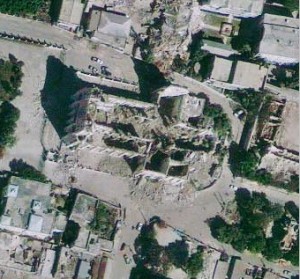Inside the DigitalGlobe, GeoEye merger
Proposed combo gets anti-trust scrutiny
"They saw blood in the water and struck," said an industry executive.
The confidential email that landed at GeoEye’s Herndon, Va., headquarters in June looked like checkmate in the company’s unexpected competition for survival against DigitalGlobe, its rival in the U.S. satellite imaging market.
The email was from the National Geospatial-Intelligence Agency, and it informed GeoEye that its imaging services would be needed for just three more months, starting in September and running through November. Out in Longmont, Colo., meanwhile, DigitalGlobe had received a much rosier email saying its imaging contract with NGA would be renewed for a full year.The emails were pivotal in the corporate jockeying and lobbying sparked by the Obama administration’s proposal to dramatically scale back a 10-year, $7.3 billion imagery purchasing program called EnhancedView, starting with a 52 percent lopping in 2013.
The NGA decision would ultimately prompt GeoEye and Digital Globe executives to agree to combine their assets under the DigitalGlobe name, pending approval by regulators.
Any visions of a breezy process were dispelled Sept. 24 when DigitalGlobe announced that the monopoly-wary Justice Department had asked the companies to open their books even further. Executives had said they expected the deal to close by the end of the year, but DigitalGlobe suggested it could spill into 2013.
Such “second requests” are not uncommon in the mergers and acquisitions arena. “It suggests there may be issues. At a minimum, it slows down the process,” said Philip Finnegan, director of corporate analysis for the Teal Group in Fairfax, Va.
The stakes are huge for the 760 employees at GeoEye, and for the future of commercial satellite imaging. The review will help determine whether one imaging company survives or two; whether the Pentagon and disaster relief agencies will have as many as seven commercial satellites at their disposal, or just three. DigitalGlobe has told investors it will save money by winnowing down today’s combined constellation of five satellites through attrition and by placing in storage one of the two satellites now in construction, GeoEye-2 or DigitalGlobe’s WorldView-3. Observers doubt DigitalGlobe would put its own satellite in storage, even though it won’t be ready until a year after GeoEye-2.
UNRAVELED PARTNERSHIP
Two years ago, none of this was expected. The EnhancedView agreements were touted by DigitalGlobe and GeoEye as shining examples of public-private partnerships. The companies were selling imagery for consumer mapping applications like Google Earth, while the U.S. government was underwriting their growth plans by paying hundreds of millions of dollars for the right to tell the companies when to swivel their satellites toward military hotspots or the aftermaths of natural disasters.
There were differences in each company’s EnhancedView agreement. The companies were going to roughly split the $7.3 billion, but GeoEye had taken up NGA on an offer to use some of the money to cover 40 percent of the cost of new satellite construction. DigitalGlobe’s deal was strictly for imaging. Despite sales to foreign governments and to search engines like Google, the biggest chunk of revenue for both companies continued to come from work for the U.S. government. DigitalGlobe puts that portion of its revenue at 60 percent.
By April, the magic of the public-private partnership had devolved into intense lobbying on Capitol Hill to undo the EnhancedView cuts. Industry lobbyists argued that the Obama proposal would undercut the same satellite builders and camera companies needed by the National Reconnaissance Office for its new spy satellites. The money also would keep DigitalGlobe and GeoEye in business, ensuring old-fashioned competition as they vied for their annual EnhancedView renewals. The trump card in the argument was this: The cuts were said to be about keeping commercial satellites from posing an existential threat to government spy satellites. DigitalGlobe and GeoEye have been buying ever more powerful satellites with resolutions approaching the centimeter scale detail of the government’s spy satellites. U.S. law, though, continues to restrict commercial imagery sales to .5 meter resolution.
MERGER CHESS MATCH
The lobbying was taking place during the run-up to the NGA decision. Out at GeoEye headquarters in the Washington suburbs, some heady corporate strategizing was also underway. CEO Matt O’Connell was about to make a bold move.
Perhaps sensing that DigitalGlobe would have an edge in the NGA competition, he tried to scoop the renewal decision with a hostile takeover bid against DigitalGlobe in May. One theory holds that GeoEye had caused bad blood with the government by accepting help with satellite construction. GeoEye points out cost sharing was an option offered by the government, so it shouldn’t have caused friction.
Within days of O’Connell’s takeover bid, DigitalGlobe rejected it.
O’Connell still thinks about that turning point: “DigitalGlobe had felt that they wanted to wait and see how the contracts went. And it turned out to be a good bet,” he told Deep Dive.
With the NGA decision in hand, the advantage belonged to DigitalGlobe CEO Jeffrey Tarr. “They saw blood in the water and struck,” as one industry executive put it.
Tarr proposed combining the companies under the DigitalGlobe name. On July 23, DigitalGlobe announced that the boards of directors of both companies had agreed to do so. O’Connell saw no choice. Crossing fingers that NGA would renew its contract every three months was not an option: “You can’t tell 760 employees ‘We’ll pay you on a month-to-month basis.’ The investors wouldn’t have stood for it,” he said.
The merger looks far from a done deal, though. The Justice Department deliberations will take place against the backdrop of a GeoEye staff that’s anxious about its future and frustrated at O’Connell for starting the merger chess match in the first place. They believe they were gaining traction on Capitol Hill until O’Connell made his play. “The staffers were like, ‘What the hell?’” one industry official said. Lobbyists were convinced they had the support of five of six congressional committees with jurisdiction over EnhancedView.
The Justice Department’s Sept. 24 “second request” for more information is not rare in the world of mergers and acquisitions, but it is significant.
An executive who asked not to be named explained the request like this: “What they’re trying to get at is, ‘Would we be viable if we didn’t merge?’”
In this executive’s view, the companies would have to restructure to cope with the EnhancedView cuts, but they could survive to retain competition in the commercial imagery market.
Out in Longmont, Colo., Tarr downplayed the significance of the Justice request in a letter to his employees: “This is a standard aspect of the regulatory process,” he told them.
Not everyone who uses commercial imagery for intelligence thinks the merger would be a bad thing. “Hopefully DOJ will approve it,” said Jonathan Hutson, director of communications for the Enough Project, an anti-genocide initiative of the Center for American Progress. “It would be great if the two companies merged and we could get the best of both,” he said.
Hutson’s group partnered with actor George Clooney in December 2010 to form a watchdog group called the Satellite Sentinel project. Digital Globe provided imagery and analysis at a steep discount. Organizers used it to document alleged atrocities by the government of Sudan in its fight against those seeking to set up the new country of South Sudan.
A combined company might be more efficient than two, even if eventually there would be fewer satellites in orbit. DigitalGlobe and GeoEye sometimes end up tasking their satellites to look at the same targets, such as North Korea last December after the death of Kim Jung-il. “Three (satellites) is probably the amount of commercial imagery that our government wants to task,” O’Connell said.




GeoEye had too much debt and not enough cash to survive the budget cuts. They’d have been out of business by 2013.